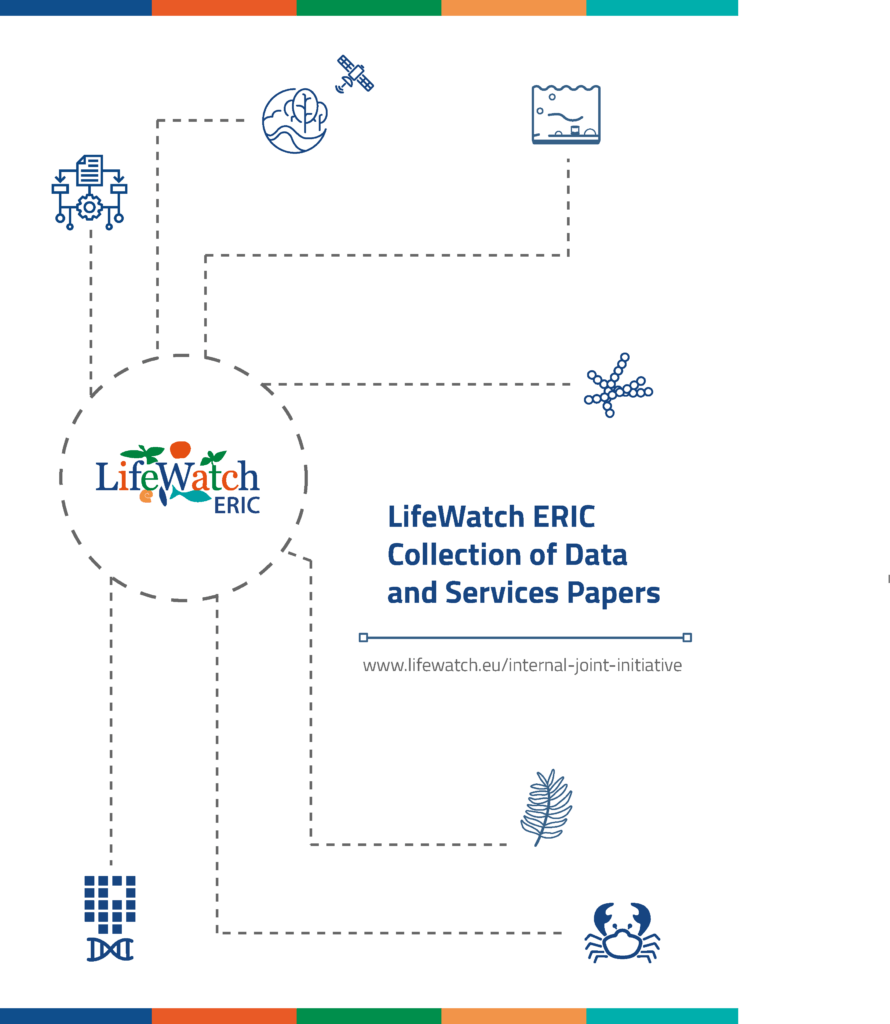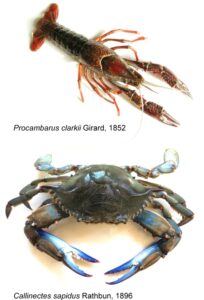LifeWatch ERIC Collection of Data and Services Papers
Edited by Christos Arvanitidis, Alberto Basset, Peter van Tienderen, Lucas de Moncuit, Cristina Isabel Huertas Olivares, Cristina Di Muri, Ana Mellado, Wouter Los
The Data and Services papers published by LifeWatch ERIC as open access papers on the Biodiversity Data Journal web page describe the resources and assets developed, upgraded and used during the implementation of the flagship project of LifeWatch ERIC, the Internal Joint Initiative (IJI).
The IJI deals with the impacts of non-indigenous invasive species (NIS) on European native species, genetic diversity, habitats, ecosystem functioning and services, as well as with our current practices in environmental management and policy implementation.
This approach is entirely interdisciplinary and makes use of disruptive technologies.
DOI: 10.3897/bdj.coll.109
Authors
Cristina Di Muri, Ilaria Rosati, Roberta Bardelli, Lucrezia Cilenti, Daniel Li Veli, Silvia Falco, Salvatrice Vizzini, George Nikolaos Katselis, Kosmas Kevrekidis, Luka Glamuzina, Giorgio Mancinelli
Keywords
invasive species, Atlantic blue crab, transitional water, stable isotope, trophic position, isotopic niche
Abstract
Background
The characterisation of functional traits of non-indigenous and invasive species is crucial to assess their impact within invaded habitats. Successful biological invasions are often facilitated by the generalist diet of the invaders which can modify their trophic position and adapt to new ecosystems determining changes in their structure and functioning. Invasive crustaceans are an illustrative example of such mechanisms since their trophic habits can determine important ecological impacts on aquatic food webs. The Atlantic blue crab Callinectes sapidus is currently established and considered invasive in the Mediterranean Sea where it has been recorded for the first time between 1947 and 1949. In the last decade, the blue crab colonised most of the eastern and central Mediterranean Sea and the Black Sea and it is currently widening its distribution towards the western region of the basin.
New information
Stable isotope analysis is increasingly used to investigate the trophic habits of invasive marine species. Here, we collated individual measures of the blue crab δ13C and δ15N values and of its potential invertebrate prey into a geo-referenced dataset. The dataset includes 360 records with 236 isotopic values of the blue crab and 224 isotopic data of potential prey collected from five countries and 12 locations between 2014 and 2019. This dataset allows the estimation of the trophic position of the blue crab within a variety of invaded ecosystems, as well as advanced quantitative comparisons of the main features of its isotopic niche.
Authors
Cristina Di Muri, Paloma Alcorlo, Roberta Bardelli, Jordi Catalan, Esperança Gacia, Maria Teresa Guerra, Ilaria Rosati, David X. Soto, Salvatrice Vizzini, Giorgio Mancinelli
Keywords
invasive species, Louisiana crayfish, red swamp crayfish, stable isotopes, ecological impact
Abstract
Background
Freshwater ecosystems are amongst the most threatened habitats on Earth; nevertheless, they support about 9.5% of the known global biodiversity while covering less than 1% of the globe’s surface. A number of anthropogenic pressures are impacting species diversity in inland waters and, amongst them, the spread of invasive alien species is considered one of the main drivers of biodiversity loss and homogenisation in freshwater habitats. Crayfish species are widely distributed freshwater invaders and, while alien species introductions occur mostly accidentally, alien crayfish are often released deliberately into new areas for commercial purposes. After their initial introduction, crayfish species can rapidly establish and reach high-density populations as a result of their adaptive functional traits, such as their generalist diet. The Louisiana crayfish Procambarus clarkii (Girard, 1852) is globally considered one of the worst invaders and its impact on recipient freshwater communities can vary from predation and competition with native species, to modification of food webs and habitat structure and introduction of pathogens. Native to the south United States and north Mexico, P. clarkii has been introduced in Europe, Asia and Africa, determining negative ecological and economic impacts in the majority of invaded habitats where it became dominant within the receiving benthic food webs. Due to its flexible feeding strategy, P. clarkii exerts adverse effects at different trophic levels, ultimately affecting the structure and dynamics of invaded food webs. It is, therefore, paramount to evaluate the ecological consequences of P. clarkii invasion and to quantify its impact in a spatially explicit context.
New information
In the past decades, the analysis of stable isotopes of carbon, nitrogen and other elements has become a popular methodology in food web ecology. Notably, stable isotope analysis has emerged as a primary tool for addressing applied issues in biodiversity conservation and management, such as the assessment of the trophic ecology of non-indigenous species in invaded habitats. Here, we built two geo-referenced datasets, resolved respectively at the population and individual scale, by collating information on δ13C and δ15N values of P. clarkii within invaded inland waters. The population-scale dataset consists of 160 carbon and nitrogen isotopic values of the Louisiana crayfish and its potential prey, including living and non-living primary producers and benthic invertebrates. The dataset resolved at individual scale consists of 1,168 isotopic records of P. clarkii. The isotopic values included within the two datasets were gathered from 10 countries located in Europe, Asia, Africa and North America, for a total of 41 studies published between 2005 and 2021. To the best of the authors’ knowledge, this effort represents the first attempt to collate in standardised datasets the sparse isotopic information of P. clarkii available in literature. The datasets lend themselves to being used for providing a spatially explicit resolution of the trophic ecology of P. clarkii and to address a variety of ecological questions concerning its ecological impact on recipient aquatic food webs.
Authors
Cristina Di Muri, Tamara Lazic, Ilaria Rosati, Cataldo Pierri, Angela Boggero, Giuseppe Corriero, Alberto Basset
Keywords
non-indigenous species, introduced species, biodiversity, transitional ecosystems, marine ecosystems, EUNIS habitats, LifeWatch
Abstract
Background
Biological invasions are one of the major threats to the ecosystem structure and functioning. After the initial introduction, frequently mediated by human activities, alien species can overcome different biogeographical and ecological barriers and determine severe impacts on native biodiversity and socio-economic activities. The Italian peninsula is located at the intersection of large trade routes within the Mediterranean Sea. Such position, along with the intense commercial activity and the high population density of the Italian coast, are considered important drivers of alien species in Italian marine and transitional ecosystems. The Italian peninsula, however, is also one of the regions with the highest native species richness within the Mediterranean Sea and, therefore, it is crucial to account for both alien and native species diversity when estimating the impact of biological invasion. Yet, such comprehensive information is frequently scattered across several biodiversity information systems and databases.
New information
Here, two datasets with alien and native species records in Italian marine and transitional waters are described. These datasets, created for the LifeWatch Italy case study on alien species, are the result of a large-scale collaboration involving experts working across the whole range of taxonomic diversity. The marine dataset includes a total of 12,219 records belonging to 3,772 species gathered from 91 investigated sites and seven EUNIS habitats. The dataset on transitional waters biodiversity includes 3,838 records belonging to 2,019 species found in 23 locations and four EUNIS habitats. Alien species were recorded in both marine and transitional waters, accounting respectively for 140 and 171 biological records belonging to 59 and 97 species. These occurrence data can be used for further research studies or management purposes, including the evaluation of the invasion risk and the formulation of alien species control and management plans. Furthermore, these compiled datasets can be used as input data for the Biotope vulnerability case study of LifeWatch ERIC, which offers a number of ICT services for the calculation of the incidence and of the impact of alien species on European biotopes.
Authors
Christopher M. Baker, Palma Blonda, Francesca Casella, Fasma Diele, Carmela Marangi, Angela Martiradonna, Francesco Montomoli, Nick Pepper, Cristiano Tamborrino, Cristina Tarantino.
Abstract
We tackle the problem of coupling a spatiotemporal model for simulating the spread and control of an invasive alien species with data coming from image processing and expert knowledge. In this study, we implement a spatially explicit optimal control model based on a reaction–diffusion equation which includes an Holling II type functional response term for modeling the density control rate. The model takes into account the budget constraint related to the control program and searches for the optimal effort allocation for the minimization of the invasive alien species density. Remote sensing and expert knowledge have been assimilated in the model to estimate the initial species distribution and its habitat suitability, empirically extracted by a land cover map of the study area. The approach has been applied to the plant species Ailanthus altissima (Mill.) Swingle within the Alta Murgia National Park. This area is one of the Natura 2000 sites under the study of the ongoing National Biodiversity Future Center (NBFC) funded by the Italian National Recovery and Resilience Plan (NRRP), and pilot site of the finished H2020 project ECOPOTENTIAL, which aimed at the integration of modeling tools and Earth Observations for a sustainable management of protected areas. Both the initial density map and the land cover map have been generated by using very high resolution satellite images and validated by means of ground truth data provided by the EU Life Alta Murgia Project (LIFE12 BIO/IT/000213), a project aimed at the eradication of A. altissima in the Alta Murgia National Park.
LifeWatch ERIC Contribution to 'Frontiers in Environmental Science'
Edited by Caterina Bergami, Institute of Marine Science, CNR, Italy
LifeWatch ERIC has contributed to the research topic “Advances in Marine and Freshwater Monitoring to support Aquatic Ecosystem Conservation and Restoration” in the journal Frontiers in Environmental Science, with the paper “The validation case on invasive crustaceans of the LifeWatch ERIC Internal Joint Initiative: State of the art and next steps forward“.
This paper demonstrates how scientists can use the data/datasets published in the Biodiveristy Data Journal together with the LifeWatch ERIC workflow to understand and eventually predict how changes in climatic conditions (e.g. temperature) might affect the trophic position of invasive omnivorous crustaceans – try the workflow yourself here.

